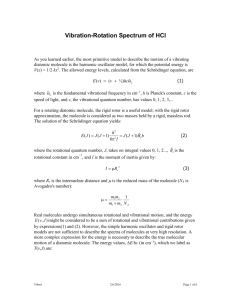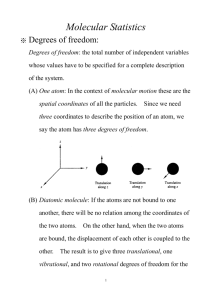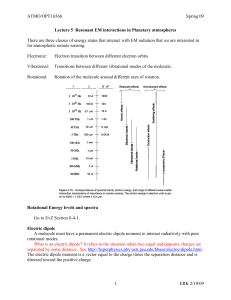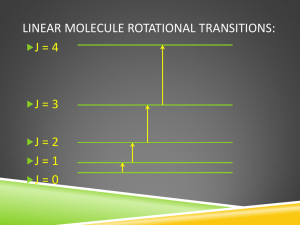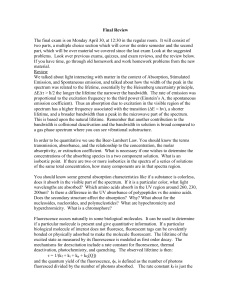Resonant_EM_interactions_atmospheres
advertisement
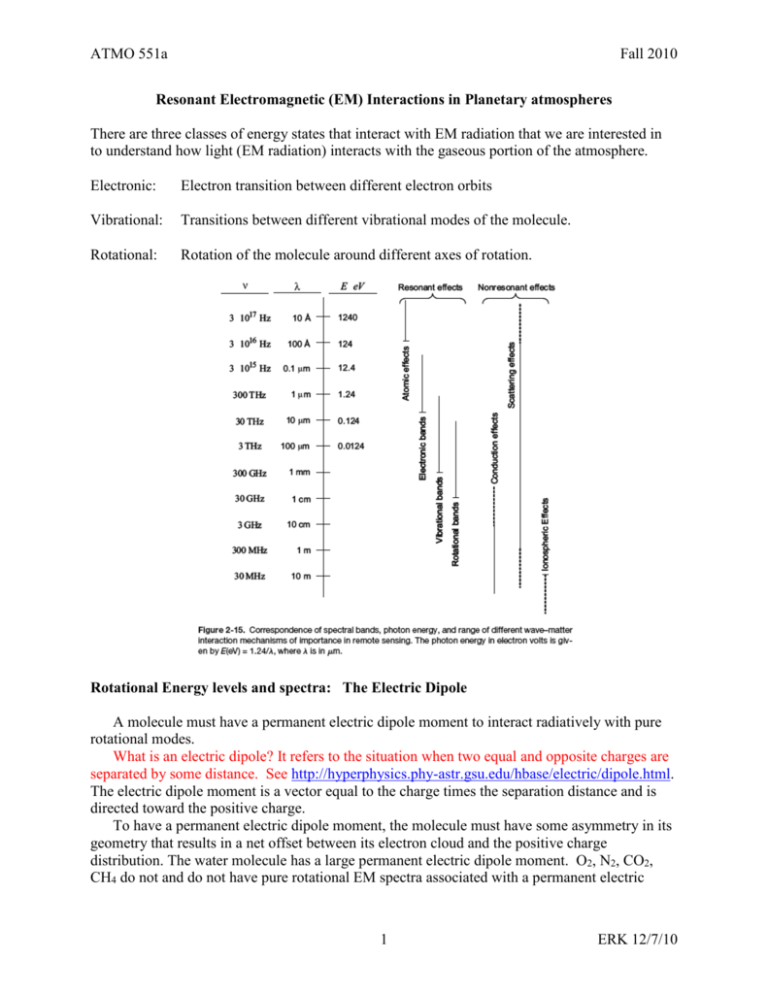
ATMO 551a Fall 2010 Resonant Electromagnetic (EM) Interactions in Planetary atmospheres There are three classes of energy states that interact with EM radiation that we are interested in to understand how light (EM radiation) interacts with the gaseous portion of the atmosphere. Electronic: Electron transition between different electron orbits Vibrational: Transitions between different vibrational modes of the molecule. Rotational: Rotation of the molecule around different axes of rotation. Rotational Energy levels and spectra: The Electric Dipole A molecule must have a permanent electric dipole moment to interact radiatively with pure rotational modes. What is an electric dipole? It refers to the situation when two equal and opposite charges are separated by some distance. See http://hyperphysics.phy-astr.gsu.edu/hbase/electric/dipole.html. The electric dipole moment is a vector equal to the charge times the separation distance and is directed toward the positive charge. To have a permanent electric dipole moment, the molecule must have some asymmetry in its geometry that results in a net offset between its electron cloud and the positive charge distribution. The water molecule has a large permanent electric dipole moment. O2, N2, CO2, CH4 do not and do not have pure rotational EM spectra associated with a permanent electric 1 ERK 12/7/10 ATMO 551a Fall 2010 dipole moment. The rotational lines are only apparent as part of the vibrational-rotational spectra of these molecules. So the vibrational line is actually a band of rotational lines centered on the vibrational line energy transition. Note, O2 has line spectra at microwave frequencies because of a magnetic dipole moment. Additional material on rotational energy transitions Recall from our discussion and the notes on heat capacity of a diatomic molecule that we discussed the rotational energy levels as being associated with the moment of inertia. This same energy distribution is relevant to interactions with electromagnetic radiation. The moment of inertia, I, is given as I r dV 2 (1) In the simple dumbbell molecule, the rotational energy levels are E h2 j j 1 8 2 I (2) units check: J2 s2/(kg m2) = J OK Reminder: Planck’s constant, h, is 6.6x10-34 J s. The absorption and emission lines associated with rotational energy levels are due to differences between these energy levels h2 E ji 2 j j 1 ii 1 h ji 8 I j j 1 ii 1 8 2I require that j = i+1, then Quantum selection rules ji ji h h h i 1i 2 ii 1 2 i 1i 2 i 2 i 1 8 I 8 I 4 I h 2 (3) (4) (5) 2 ERK 12/7/10 ATMO 551a Fall 2010 From Figure 3.7 of Graeme Stephens’ textbook To get a feel for the spectral frequencies here, let’s consider the water molecule. It consists of one oxygen atom and 2 hydrogen atoms. It’s geometry is given in Elachi and van Zyl (EvZ) Figures 8-4 and 8-5. The angle between the two O-H lines is 104o, a bit more than 90°. The length of each OH line is 0.96 Å =0.96x10-10 m. Water has three different rotational modes plus all of the energy levels for each mode and the energy transitions between modes creating a rich and complex rotational spectrum. To estimate I, assume the first rotational mode in EvZ, spinning around a line drawn through the oxygen atom and splitting the 2 hydrogen atoms. The center of mass is essentially in the oxygen atom. The distance of the each hydrogen atom to the spin axis is r =0.96x10-10 sin(52o) m = 0.76x10-10 m The hydrogen atom mass is 1.7x10-27 kg. So Ih2o ~ 2 m r2 where m is the mass of each hydrogen atom I = 2 x 1.7x10-27 x 0.57x10-20 = 1.9× 10-47 kg m2. So h/(42I) = 6.626068 × 10-34/40/ 1.9× 10-47 = 8.6 x 1011 Hz = 860 GHz. The lowest transition is from j=0 to j=1 yielding a frequency of h/(42I) = 860 GHz. The corresponding wavelength is 0.35 mm. This is an approximate estimate that gets us to the approximate frequency and wavelength regime of the strong water rotational lines. 3 ERK 12/7/10 ATMO 551a Fall 2010 Water’s pure rotational lines are relatively high in frequency because of the low mass of the hydrogen atoms. The frequency is inversely proportional to I =mr2 so small mass mean high frequency. Figure 10-1 from EvZ. Rotational line spectrum of H2O. Scale: 100 cm-1 = 3,000 GHz Remembering from the Einstein coefficients, note that the line strengths are associated with the Boltzmann distribution of the energy levels and the energy separation between the lines which defines the net absorption resulting from the absorption minus the stimulated emission. See water vapor spectrum EvZ figure 8-6 These transitions produce a near continuum in the far IR of Earth’s emission and absorption spectrum. 4 ERK 12/7/10 ATMO 551a Fall 2010 CO: CO is a simple 2 atom molecule which is asymmetric so the dumbbell rotational model works. The rotational spectrum consists of approximately equally spaced rotational absorption lines spaced about 110 GHz apart. The isotopes like CO18 have very similar spectra. CO2: Fundamental rotational frequency is 72 GHz. The EM spectrum of rotational lines only exists as lines in a vibrational-rotational spectrum. CO2 has no pure rotational EM spectrum. The pure rotational energy levels of the molecule exist but they don’t interact with EM radiation. The rotational lines are only apparent as part of the vibrational-rotational spectra of these molecules. So the vibrational line is actually a band of rotational lines centered on the vibrational line energy transition. 5 ERK 12/7/10 ATMO 551a Fall 2010 Vibrational energy levels and spectra Molecules vibrate when excited. An example of CO2 vibrational modes is given below, Figure 3.8 from G. Stephens’ textbook. The vibration can be thought of in terms of the simple harmonic oscillator (SHO) model where there is a restoring force that drives the oscillator back towards its nominal position or configuration F=-kx’ (6) where F is a force, x’ is a displacement from a nominal position, in this case x’=0 and k is a spring constant. The frequency of the oscillation that results from such a simple restoring force is 6 ERK 12/7/10 ATMO 551a Fall 2010 v' 1 2 k (7) where is the reduced mass for the system. In the case of a 2 atom molecule, the reduced mass is M1 M 2 (8) M1 M 2 where M1 and M2 are the masses of the two atoms in the molecule. When we do the quantum mechanical version of a SHO, the energy levels and frequency of the SHO are quantized such that 1 1 v 2 2 1 v ' 2 k (9) where is the vibrational quantum number, 0,1,….. Estimating VibrationalEnergy Levels The vibrational frequency of the molecules of interest depends on each molecule’s spring constants, k. There are multiple spring constants for each molecule because there are multiple vibrational modes for each molecule (see Figure above as example). Textbooks say (correctly) that the vibrational energy spectrum is at higher frequencies than the rotational spectrum. So how can we estimate k to get a sense of what molecular vibrational energy levels look like and what frequencies and wavelengths are typical of vibrational EM spectrum. Let’s try water. We should be able to get a sense of the magnitude of the restoring force to the crystal lattice by looking at how much energy it takes to move a molecule of water out of the lattice (the latent heat). We can then set this equal to WORK required to move a molecule out of the lattice. WORK is force times distance. We know the separation distance between molecules so we can figure out the force. Knowing the force we can estimate the spring constant approximately. As all atmospheric scientists should know, the binding energy of water is the latent heat of water, that is the amount of energy required to move water from a condensed state to the gas phase. The latent heat is about 2.5e6 J/kg at typical Earth temperatures. Strictly speaking this is the energy to move water from the liquid phase to the gas phase but the extra energy to go from solid to liquid is only about another 10% and we are only trying to get a crude estimate. We convert J/kg to J/molecule using 0.018 kg/mole for water and 1 mole = 6x1023 molecules So the energy to free 1 water molecule is 2.5e6 J/kg * 0.018 kg/mole * 1/6e23 mole/molecule 2.5/6 x 10(6-23) = 4 x 10-18 J/molecule = 25 eV/molecule where 1.6e-19 J/eV. Now we set this energy equal to “WORK” = Favg d. The distance to separate a water molecule from the other water molecules is approximately 1Å =10-10 m which is the distance between water molecules. So Favg = 4x10-18/10-10 = 4x10-8 kg m/s2. Now we set Favg equal to –kx where we choose x to be about half of d to be crudely representative. 7 ERK 12/7/10 ATMO 551a Fall 2010 Favg = kx for x=0.5x10-10 So k = 4x10-8 /0.5x10-10 = 8 x 102 kg/s2. As a crude estimate of the reduced mass of a water molecule, we approximate it as 0.018 kg/6x1013 molecules/3 because there are 3 atoms in the water molecule. Plugging this k into the vibrational frequency equation, we get v’ = 4.5x1013 Hz Note that this frequency is quite a bit higher than the rotational constant frequency (9x1011 Hz) we estimated previously for water. So indeed the vibrational spectrum is significantly higher in frequency and energy than the rotational spectrum. This frequency corresponds to a wavelength of 6 microns which is indeed in the thermal IR band. The photon energy hv’ = 6.6e-34 J sec x 4.5x1013 Hz = 3x10-20 J. We divide this by 1.6x10-19 J/eV to get 0.2 eV which is indeed in the IR range Another approach to estimating the spring constant is to use either the bulk modulus or Young’s modulus. Young’s modulus, E, is a property of the solid equal to the stress (force /area) divided by the strain, the fractional change in length. Consider a rod where we apply a compressional force, F, on each end and then measure how much the rod shortens, L/L where L is the original length of the rod. E = stress/strain = F/A /(L/L) (10) A is the surface area over which the force is applied. Solving for F we get F = EA L/L. Assuming A~L2, then F ~ EL L . Our spring constant is therefore k = EL. We take E of steel to be representative, Esteel = 2x1011 N/m2. For a molecule, we’ll take L ~ 2Å. So EL = k = 2e11 N/m2 x 2e-10m = 40 N/m. Plugging this into the vibrational frequency equation, v' 1 2 k (11) we get that for water, the frequency is 1013 Hz. This corresponds to a wavelength of 30 microns. The frequency is a bit too low and the wavelength a bit too long but it is in the right range approximately. So these crude physical arguments have given us a simple understanding of the vibrational restoring force and why the vibrational frequencies and energies are typically in the thermal IR band. 8 ERK 12/7/10 ATMO 551a Fall 2010 Vibrational-Rotational Spectrum The vibrational ‘line’ is actually a band of rotational lines centered on the vibrational line energy transition. For molecules with no permanent dipole moment, the rotational lines are only apparent as part of the vibrational-rotational spectra of these molecules. The selection rules are J=+1 and = +1. The R and P branches in the figure are defined as follows. The R-branch is J = +1. The P-branch is J = 1. v0 is the frequency of the nominal vibrational line center. Crossection associated with gas absorption & emission Now we return to an equation that we introduced briefly for (= k) that represents the absorption coefficient for gases kv, Sv, f 0 where S is the line strength of the absorption line, f represents the shape of the absorption line, is the frequency of the measurement and 0 is the line center of the absorption line. The line shape is due to a combination of Doppler and pressure broadening. The line strength is given as gi exp E i kT Cij n gi exp E i kT Cij h / kT h / kT 1 e ij n m 1 e ij Z c n Z c where nm is the number density of molecule: m, n is the total number density of the bulk gas = P/kBT and nm/n is the volume mixing ratio of constituent m of the gas, Ei is the energy of the lower energy level (i and j) of the molecule, 0 = ij , g is the number of states that have this Sv, nm particular energy transition, Z is the partition function which is g exp E i i k B T which is the i sum of population of all of the available states at a particular temperature, T, and Cij is an electromagnetic coupling factor forthisparticular energy transition. Remember that the distribution of the population of molecules is defined by the Boltzmann distribution h / kT The 1 e ij term represents the absorption minus the stimulated emission term. The stimulated emission term is the term responsible for lasers. We can write these equations in terms of crosssections by recognizing the following 9 ERK 12/7/10 ATMO 551a Fall 2010 gi exp E i kT Cij h / kT 1 e ij f 0 Z c but as we have discussed, the extinction, absorption or scattering coefficient can be thought of and written as a crossection per particle or molecule times the number density of particles or molecules k=n (15) kv, Sv, f 0 nm So (14) and (15) imply that the absorption crosssection of a gas molecule at a particular frequency and pressure is given by gi exp E i kT Cij h / kT 1 e ij f 0 Z c So even the absorption (and emission) by gases has an effective crosssection related to how it interacts with EM radiation. v, Next we discuss the lineshape function, f(v-v0). 10 ERK 12/7/10
